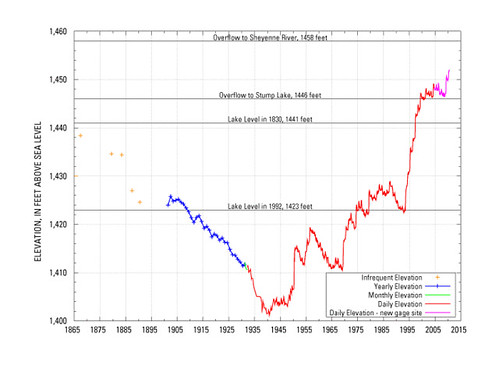
The Grand Forks Herald reports that Amtrak's Empire Builder has been diverted due to the rising waters of Devils Lake. The lake doesn't have a natural outlet, and has been rising for decades. The most recent period of rising waters has occurred since 1993, bringing the water level up by 30 feet and inundating huge swaths of land. The rise has been slowed in recent years due to overflow into nearby Stump Lake, but it has continued to go up.
Amtrak had previously said they would reroute the train once the lake reached 1,543 feet above sea level, which appears to have first occurred on the evening of April 22nd. The train finally started to be rerouted this past Saturday night (April 30th), suspending service to Grand Forks, Devils Lake, and Rugby. The three cities (primarily Grand Forks) contribute about $2.9 million in ticket revenue to the Builder annually.
The rerouting will put the train on a diagonal route along the KO Subdivision between Fargo and Minot, which I understand is actually less populated than the normal routing (though again, it may be primarily due to Grand Forks). Amtrak says that they'll run buses along the old route for about a month, but it's anyone's guess beyond that point. There has been pre-existing bus service along the U.S. Highway 2 corridor from Grand Forks to Minot, but it has only operated 4 times a week on Sunday, Monday, Wednesday, and Friday.
This may only be a seasonal problem this year, as the water level tends to spike in the spring and then decline and level off. However, the rail line has only been minimially maintained for the last few years. BNSF stopped running freight trains along the route in 2009, and I've heard that it has become a bumpy ride for Amtrak passengers. The flooding will certainly not help the state of the tracks.
It's estimated that it will cost $100 million to repair and upgrade two bridges and a 17-mile stretch of track in the vicinity of Churchs Ferry. The bridges will cost about $55 million over the course of about two years, while the remaining $45 million for track could be stretched out over a period of 5–10 years. The rails only need to be raised by 5 feet or so—once Devils Lake reaches 1,478 or 1,479 feet, it will overflow into the Sheyenne River, a tributary of the Red River of the North which flows into Canada.
Some pumping systems have been installed over the years to try and mitigate the rising waters, and they might prevent the water from ever overflowing naturally. However, given the history of the lake's rise, I suspect the level will keep rising until overflow occurs.
No comments:
Post a Comment